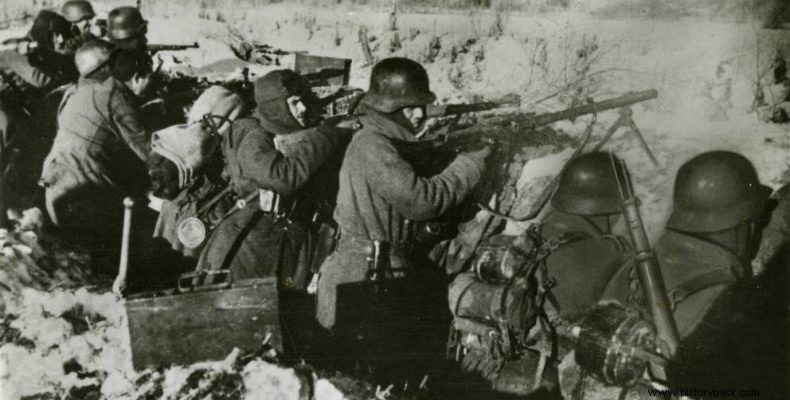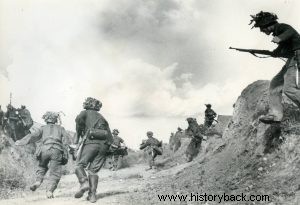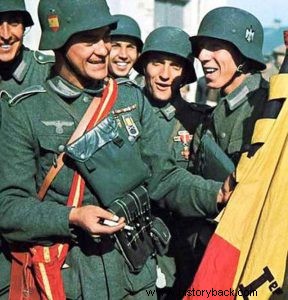
Although Spain remained neutral in World War II, Franco, and because of the help he had received from Hitler during the Spanish Civil War, allowed the recruitment of volunteers on behalf of the German army with the prospect of fighting, strictly , on the Eastern Front against the Bolsheviks.
Hitler approved the use of Spanish volunteers. Franco intended to raise a brigade of 4,000 men, but soon so many volunteers came forward that a full division of 18,000 men was raised.
Gathering and composition
Half of the officers and non-commissioned officers belonged to the Spanish army and had combat experience. Many volunteers were members of the Spanish Falange nationalist party. Others were former democrat fighters, or relatives of democrats looking for a way to "cleanse". Also a small number of volunteers were Portuguese.
The commander of the division, which was called "Blue" because of the blue shirts of the "Falanga" they wore, was General Augustinos Munioth Grantes. Spanish volunteers began arriving in Germany in mid-July 1941. Their division acquired the number 250 in the German Army's order of battle.
The division originally had four infantry regiments, but was soon organized like the standard German division of the time with three infantry regiments (262nd, 263rd and 269th), an assault battalion, four-division artillery regiment, anti-tank battalion, reconnaissance division, battalion engineer, transfer battalion, replacement battalion and services.
On the forehead
The 250th Infantry Division (IP) was assigned to Army Group (OC) Center initially, but was subsequently placed under the Northern Army and sent to the Leningrad front, attached to the German 16th Army. The 250th MP was deployed in the area of the Volkov River in the area of Lake Ilmen, covering a 50 km front.
It was later moved south of the Neva River participating in the blockade of Leningrad. During this time its administration was taken over by General Emilio Esteban Infante. The division, due to the battles and weather conditions, had remained a shadow of itself, having only 5,900 men.
The Battle of Krasni Bor
On February 10, the Soviet 55th Army attacked the Spanish positions in order to break the siege of Leningrad. At least 1,000 guns, rocket launchers and mortars dug into the positions of the 250th MP. After a heavy bombardment of two hours, three Soviet rifle divisions, reinforced by tanks, rushed out.
The Spaniards facing almost seven times their forces fought in many cases to the death as they could not retreat anyway due to the Soviet barrier. The Soviets broke the Spanish front but in the village of Krosny Bor a Spanish company repulsed all Soviet attacks, entrenched at the railway station, although it was left with 40 men.
The Spaniards were surrounded everywhere but did not give up the fight determined to die fighting. Spanish pioneers, gunners and auxiliaries all fought as infantrymen desperately holding the eastern part of the village despite the Soviet attacks. The Soviets even attacked Spanish ambulances with tanks but soon the latter responded with Molotov cocktails setting several Soviet tanks on fire.
In the afternoon the battle continued fiercely with the indomitable Spaniards holding out. With the reinforcement of German units, the Spanish managed to retreat to the location of the Izora River, west of the village. There they faced all the Soviet attacks. Finally the attack of the Soviet 72nd Rifle Division (MT) forced the Spanish into another small retreat. The 72nd MT, however, lost 70% of its strength in this engagement to the fanatical Spaniards who also suffered heavy losses.
The battle continued the next day with the Soviets mopping up the last Spanish resistance in the village. But the Soviet 55th Army had already suffered losses of around 35%. The next day the Spanish launched a small-scale counter-attack. On February 13, the 55th Army launched its final offensive with the assistance of the Soviet 67th Army.
However, the Soviet attacks were repulsed with heavy losses for the attackers. The Soviet Operation "Polar Star" had failed thanks also to the fanatical resistance of the Spanish. On February 15, the 250th MP reported losses of 3,945 dead, wounded and missing as a result of the battle. However, in return he had killed 11,000 Soviets.
Dissolution
In total, more than 45,000 Spaniards served in the ranks of the 250th MP. However, after the heavy losses in the battle of Krasny Bor and the intense pressure of the Western Allies towards the Franco regime, Madrid decided to withdraw the division. After intensive negotiations with the Germans, the division was withdrawn in October 1943. However, approximately 3,000 men remained, voluntarily, in German service and fought until the Battle of Berlin.


